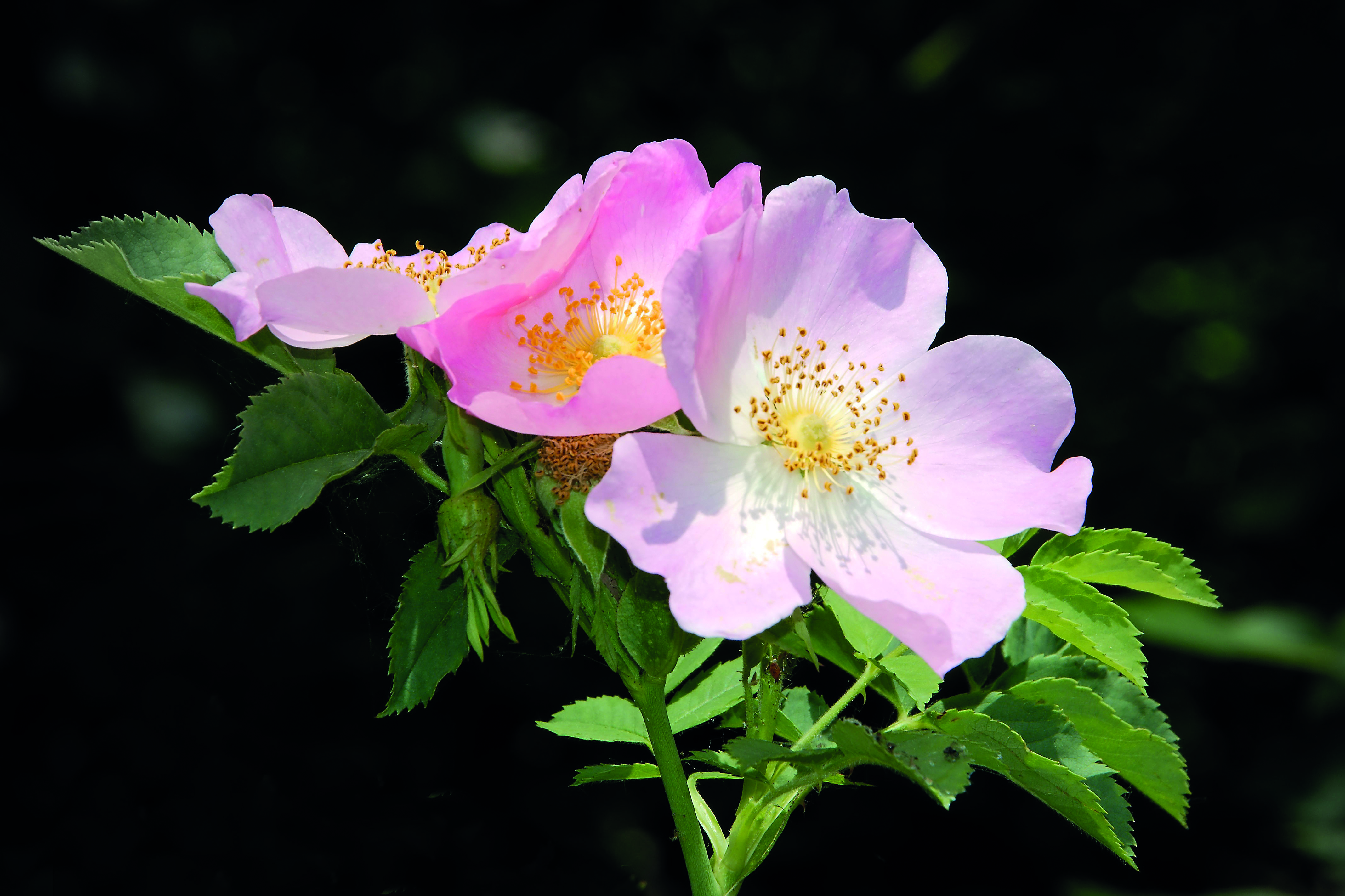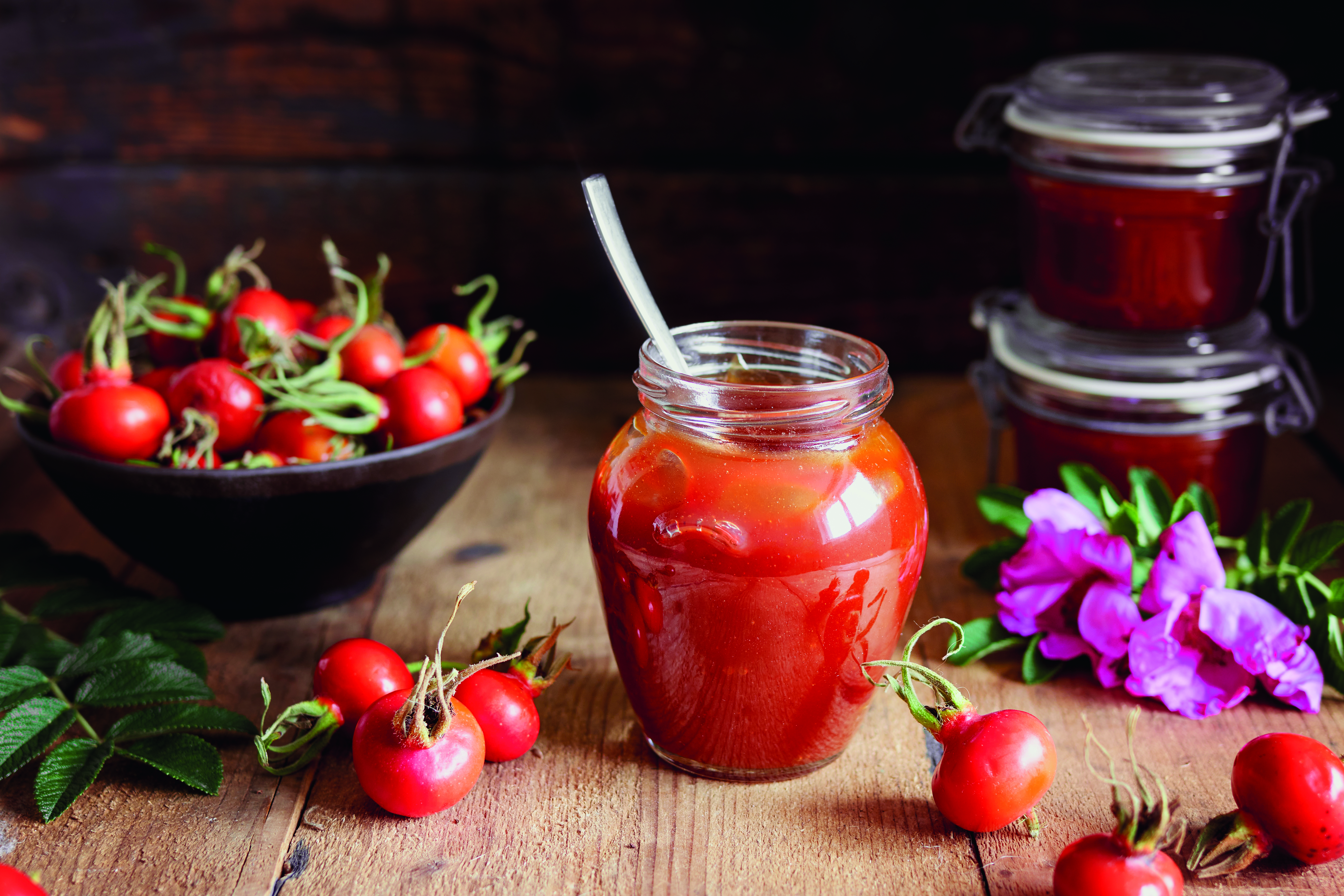
plant of the month: dog rose
Dog rose, a climbing plant which is also known as wild rose or eglantine, is a joyful addition to hedgerows and gardens. Its Latin name is Rosa canina, thought to reflect the fact the thorns loosely resemble the ‘canine’ teeth of dogs – and children will definitely get ‘bitten’ by dog rose stems if they aren’t careful handling the plant.
fact file
If you don’t have a dog rose in the setting, find one nearby and bring a bough in each month so that children can talk about the changes they observe through the year.
Tiny buds emerge on the dog rose’s branches in early spring, growing chunky and with long ‘sepals’ protecting the petals developing inside.
The flowers burst open with a delightful, mild fragrance, and insects come to gather nectar and pollen; each flower has five petals. As spring progresses, the blossom falls to the ground or blows away.
The part of the flower bud left behind regenerates into rose hips, turning from soft green to hard orangey-red.
Dog rose hips contain the seeds, and these are distributed by birds and animals that eat them (and then leave droppings containing the seeds) or by the wind blowing them away.
stories
Flowers feature in many children’s stories, although dog roses are harder to find.  The thorns do feature though, and the traditional Sleeping Beauty tale centres on Briar Rose, who pricks her finger on a spindle, and while she sleeps, a huge thorny rose hedge grows around her castle and the leaves of a rose in her bedroom slowly drop to the floor, marking the passing of time.
The thorns do feature though, and the traditional Sleeping Beauty tale centres on Briar Rose, who pricks her finger on a spindle, and while she sleeps, a huge thorny rose hedge grows around her castle and the leaves of a rose in her bedroom slowly drop to the floor, marking the passing of time.
sensory dog rose
Ask parents and neighbours if they can bring you a rose bloom from their own gardens and place each one into its own jam jar of water, along with two or three dog rose or wild rose specimens. Cultivated roses can be found in hundreds of varieties and are very different from wild roses. Place the jars in a sunny spot outdoors and ask children to use their senses to describe the differences:
- the colours, shapes and sizes they can see, the number of petals each rose has
- the distinctive scent each rose gives out
- the texture of the petals, stems and what the thorns feel like
- rose petals are edible and the sweeter the smell, the more delicious the taste!
- can children hear anything? Fresh cut roses may still attract small insects.

dog rose springboards
In spring, make perfumes: give children small containers (‘mortars’) and gather short sticks to use as pestles. Collect handfuls of dog rose petals and pound them in the containers, adding a little water to create a paste. Thick pastes make good paints or potions and are harmless to use on children’s skin or to decorate mud kitchen creations.
I always think dog roses are the quintessential children’s flowers – they look just like a child’s stylised drawing of a flower. Use summertime dog rose flowers to explore the parts of a real flower, snipping a few flower heads directly from the plant and including 5cm of the stem, too. Encourage children to carefully pull the specimens apart, examining each piece with magnifying glasses and placing them onto a piece of white paper. They should end up with five pinky-white petals, five green sepals (that the flower bud grew inside of), dozens of stamen, some of which will have pollen on the end, and a chunky section under the flower, where the rose hip is still forming – it’s called the receptacle. Take care with the length of stem as it is likely to have small but annoying thorns on it. Can children reassemble their flower in the right order on their piece of paper?
If you have a dog rose in your setting, late autumn is the time to trim it back to stimulate strong growth next year. Once the shrub has finished flowering, it is safe to prune, although you may choose to leave it later in the year, so give wildlife a chance to share the rose hips with you. Pruning is an important annual task for ‘cultivated’ garden plants, and small secateurs that three- and four-year-olds can use, with guidance, will enable them to participate fully in this job; the Neilsen mini-pruners are good value.
In winter, wait for the first frost before collecting rose hips and slicing them up to examine the insides. What other fruit do children know that look similar?
myth, magic and culture
The rose is the national flower of England and is common on flags, emblems and on historic documents, but the rose we see in gardens is onlya distant relative of the native five-petaled dog rose. Print a few images of roses in heraldry (search for ‘wild rose heraldry’) and provide children with paper collage pieces to use to create their own interpretations of crowns, etc.
Dog rose was once used as a medicine, including to cure scurvy as the rose hips are full of vitamin C. In World War 2, communities made a syrup from them to make up for their lack of fruit – but note, humans can’t eat raw rose hips!
In mythology, wild roses and dog roses represent love, beauty and purity and are often seen on tattoos, church windows, tapestries and in paintings. House or business name plates, shop windows and road signs are good places to find them.
superhero feature
Rose hips were used as far back as ancient Greece and Rome, and today we carry on the tradition of harvesting rose hips for a variety of uses. From the plant’s perspective, its thorny branches are its superhero feature – they repel predators and give it extra strength.
dog rose STEM projects
Rose petal cordial: collect a colander full of petals – picked rather than scavenged – and shake them to ensure all insects are loosened. Weigh the petals and note down the quantity, then gently wash. Place them in a large, clean, glass bowl, adding three times the amount of water as petals. Leave to infuse overnight. The next day, drain the water into a pan, add 2 to 3 times the amount of sugar as petals and heat to boiling. Add the petals and simmer until the cordial starts to thicken. Remove the petals with a slotted spoon, strain the cordial through a muslin cloth into a sterilised bowl or pan and then decant into sterilised bottles and jars.
In autumn, make rose hip jelly. Forage for equal volume quantities of crab apples and rose hips. Give them a clean but don’t worry too much about apple pips – pull off the stems, though (a good fine motor skill activity). Place both fruits into a large pan and add water to cover them. The apples add pectin – that’s what creates the ‘jelly’ effect. Bring the pan to the boil and keep simmering until the fruit starts to go mushy, adding water if needed. On the hob this could take an hour. Mash up the fruit in the pan, then strain it through a sieve into a large bowl and discard the pulp. Weigh the amount of juice you now have, pour it back into a clean pan and add an equal amount of sugar. Bring to the boil, then simmer to thicken.

next month – grass
The ‘dog days’ of summer are on their way and next month I’m going to look at grass – yes, really. There is a world of exploration and fun in this apparently humble plant. If you have grass at your setting, and it’s possible, don’t mow it until you’ve read next month’sNursery World.
aims of this series
Many of us suffer from ‘plant blindness’. But if we don’t notice common plants around us, how can we teach the next generation to care for plants which feed us, give us medicine, clothes and many other things upon which we depend? So, every month during 2023, we’ll look at some of the main features of common plants and explore how to make the most of them for play and learning.
To collect dog roses for examination, you’ll benefit from thick ‘rigger’ gloves to avoid being grabbed by the ‘dog tooth’ thorns. As always, a variety of different sizes of magnifiers are a great STEM resource for young children.









